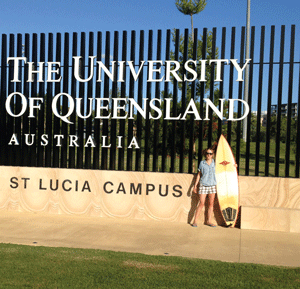UQ simplifies managing student life

The quest to automate manual processes to improve organisational efficiency at the University of Queensland is one step further along the road with the implementation of an EzeScan solution to register student email into its HP TRIM EDRMS.
Since the introduction of TRIM at the university in 2005, the job of placing individual emails into the EDRMS had been done manually, with up to two staff working fulltime on the job. Staff who interact with students are required to include their student ID number in the email subject header which is used by records staff to look up the student file. Staff are asked to copy in the dedicated Records and Archives Management Services (RAMS) email address for all correspondence.
“We’ve got thousands of staff that are interacting with students on a daily basis,” said Patrick Carswell, Manager - Records and Archives Management Services (RAMS).
“We’ve got a small footprint for TRIM, with just 250 licences for over 9000 staff, so we asked staff to carbon copy their email to this particular mail box and we’ll put it into the student file for you.”
“So our staff would just grab that number, register it and then try and find that student file. On average, depending on how fast they were, it would take at least 30 seconds for them to do a single email. And when you’re talking about hundreds and hundreds and sometimes thousands a day, it got ridiculously out of hand.” If the student file didn’t exist, records staff would manually copy and paste this information from the student system into TRIM which could take up to four minutes per student.
Mike Kirkby, Managing Director of EzeScan said, “For the UQ installation we are processing incoming emails and using the information (unique student number) in them to correctly register the emails in their EDRMS (TRIM),
This is being achieved by using EzeScan Professional Document Management Bundle with Email Record Capture.”
“By using this combination of our products, the original emails are being processed from a folder in an Exchange mailbox and moved to another mailbox when they have been processed. Data is automatically extracted from the email and used to identify the TRIM location that the email is to be stored in (per student). The emails are being stored in TRIM in their original format (as emails with attachments) to comply with record keeping requirements.” said Mr Kirkby.
“A small number of exceptions with no valid identifying information are sent to a designated TRIM container where they can be easily dealt with.”
“We still have to do a small amount of QA, that hasn’t disappeared but it just took out that whole manual registration side of things,” said Carswell, who believes this is just the start in improving UQ’s record-keeping practices.
“We look forward to working closely with EzeScan into the future to expand this automatic registration across other areas and to introduce barcodes, OCR and workflows to improve form registration and processing.”
“Whether you are a University or a business, most general staff are very reluctant to do record keeping. So I believe a good record keeping system would be one that could work in the background and do what’s required without the end user having to do really anything at all and that very rarely happens.
“Currently, unless the person makes a concerted approach to say I’m going to register this or I’m going to send it to through to someone who can register it, all that information just stays in Outlook and eventually will just disappear.”
“We need to get better at interrogating email by keyword and automating capture into TRIM. At the moment we are using TRIM for student files but the default records management system across campus is Outlook or a shared drive.
A modification to the University’s PeopleSoft student management application automatically creates a student file in TRIM so the emails have somewhere to go.
Forms processing is still handled manually with RAMS’ three Fujitsu FI5650C scanners working fulltime to ingest images of student applications.
There are plenty of advantages to membership of the elite club comprising Australia’s eight six “sandstone universities” (GO8) although all that tradition can be something of a burden when it comes to modernising business practices that have been in place for over 100 years .
So the university is still using paper-based workflow and traditional wet signatures for its processes and is yet to implement any digital workflow.”
“Often size can be an advantage but in some cases it can often be to the detriment of change and innovation. When you look at smaller Universities, they’re leaps and bounds ahead of us in this respect.”
“It’s a lot easier for a university that’s only 20 years old, they can implement changes a lot faster and the people are willing to make the change because they’ve probably started in the digital era so to them paper is old school already whereas we’re over 100 years old so paper has always been a part of our history and it’s going to take a lot to get them to move away,” said Carswell.
“Whereas up until recently it retained everything in a physical archive the university is now scanning and disposing of the physical copies after three years using an approved disposal after digitisation strategy.”
